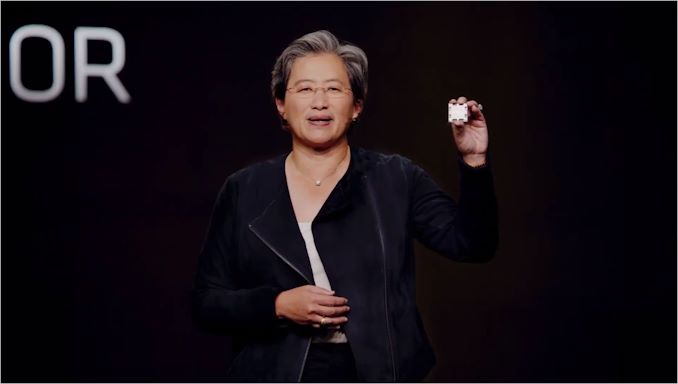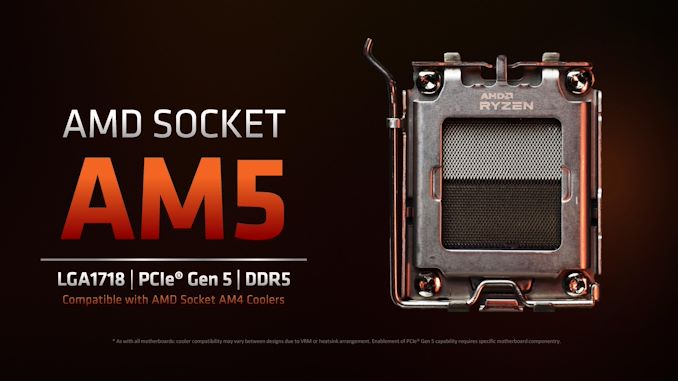CES 2022: AMD’s Next-Gen AM5 Platform to Have Long Term Support
by Dr. Ian Cutress on January 7, 2022 9:00 AM EST- Posted in
- CPUs
- AMD
- Trade Shows
- AM4
- Lisa Su
- Zen 4
- CES 2022
- AM5
- Ryzen 7000

One of the key aspects of AMD’s offering in the consumer desktop space is the longevity of its socket and platform. Throughout the years, AMD has leveraged a single socket for multiple generations, providing users the ability to keep the same motherboard year in and year out, while the competition changes the socket every couple of generations at best. To keep that mantra, AMD has stated that its next-generation platform coming later this year, AM5, will also be a multi-generational platform.
Going back in AMD’s history we can see just how long various platforms have lasted, from first processor launch to last processor launch:
- Socket 939 from 2004 to 2006
- AM2/2+ socket from 2006 to 2009
- AM3/3+ socket from 2009 to 2013
- FM2/2+ socket from 2012 to 2015
- AM4 socket from 2016 to 2021
- AM5 socket from 2021 to ...
Within that time there have been chipset updates to allow for better IO, however usually the socket change has happened because of DDR version changes, interconnect, and PCIe. In this instance, the move from AM4 to AM5 comes with a change from DDR4 to DDR5 and PCIe 4.0 to PCIe 5.0.
In a roundtable with Dr. Lisa Su, the question was asked about how long AM5 would be around – now that AMD has a sustainable position again in the desktop, and by many measures a leading position, would AMD continue its tradition of longer-lived desktop platforms. Dr. Su stated that AM4 ‘has been good for the community and … it’s been good for us as well’. She confirmed that a change was required with the new standards, but on strategy it was put that ‘I don’t have an exact number of years but I would say that you should expect that AM5 will be a long-lived platform as AM4 has been’. Dr. Su also stated that even with the introduction of AM5, the company expects AM4 to stay in the marketplace for some years, with overlap between the two depending on the market.
For users wondering how far AM5 can go before it needs to change again, it’s worth looking at roadmaps for the two usual elements that cause socket updates: memory and PCIe. We’re only just on the transition to DDR5, and DDR6 is a long way away – in a recent Samsung presentation, for example, it listed DDR6 as a 2028 technology. Similarly with PCIe 5.0, the same presentation puts PCIe 6.0 as a 2026 technology, and PCIe 7.0 as a 2029 technology. So unless AMD wants to increase the pin count on the CPUs for more memory channels or more PCIe lanes, the PCIe 5.0+DDR5 combination looks set until at least 2026.











42 Comments
View All Comments
Dolda2000 - Friday, January 7, 2022 - link
I too upgrade rather seldom (I'm currently writing this on Sandy Bridge), but I nevertheless appreciate the modularity of long-lived platforms. One of the nice thing with DIY computers is that you tend to end up with a wee bit of a stockpile of spare parts, and being able to cross-match them in ways that you didn't necessarily have to foresee when your first bought them is very, very nice.TiO2 - Friday, January 7, 2022 - link
Ask all the B350/X370 motherboard users what "5 years of AM4 support" meant to them - that promise was worthless and they relied on semantics to get themselves out of it. AMD is actively blocking Ryzen 5000 on 300-series chipsets, which have identical silicon to the 400-series, and for which working beta BIOSes were available with Ryzen 5000 support. It also took tons and tons of community pressure for AMD to agree to support Ryzen 5000 on B450/X470 (they were initially only planned to be compatible with B550/X570). Don't trust this at all.cfenton - Friday, January 7, 2022 - link
I'm one of those B350 users and it was very disappointing that they locked me out of Ryzen 5000. I ended up going from a 1700 to a 3800XT because I got a good deal on one shortly before Ryzen 5000 released. I would have gladly paid more for the 5800x or 5900x, but AMD didn't give me that option.I wouldn't trust them to support the early AM5 boards for the lifetime of the socket.
GeoffreyA - Saturday, January 8, 2022 - link
300-series motherboards might end up getting support.https://www.tomshardware.com/news/amd-exploring-ry...
Shlong - Wednesday, January 12, 2022 - link
As an X370 Taichi owner, I went from 1700X to 2700X to 3900X and now 5900X (using 6.62 beta bios). ASRock has released an official bios with updated AGESA supporting 5000 series for the X370 Pro this week so I think we're gonna see official Bioses for the X370 boards soon to support 5000 series.Cygni - Friday, January 7, 2022 - link
There is some selective memory about the AMD sockets in this article. While a lot of the mainline platforms did have fairly long lives, CPU support was often bifurcated and spotty, and there are a great many platforms that AMD dropped like a rock after a single CPU release cycle. Remember AM1's promised "three generations"? FM1? QuadFX/4x4? And even more recently, TRX40?So while I do hope the fiasco around AMD trying to keep Zen 3 off of B450 is fresh in their minds, it is always helpful to take what these multi-billion dollar megacorps with terrible track records say with a big helping of "believe it when you see it".
Oxford Guy - Saturday, January 8, 2022 - link
First-generation Threadripper boards don’t support generation 2 CPUs.artk2219 - Sunday, January 9, 2022 - link
Thanks for mentioning these, I was just about to do the same thing as a former FM1 and current x399 owner. It sure would have been nice to move to an appreciably better chip than my 1920x without a platform update.dwillmore - Friday, January 7, 2022 - link
What about Socket 754? We ignoring that?GeoffreyA - Friday, January 7, 2022 - link
Unfortunately, I had one of those.